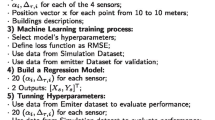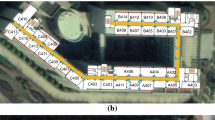Abstract
Indoor positioning systems answer the need for ubiquitous localisation systems. Frequently, indoor positioning relies on machine learning models developed based on the training data composed of WiFi received signal strength (RSS) vectors observed in different indoor locations. However, this requires expensive collection of RSS vectors in precisely measured locations. In this study, we propose a semi-supervised method, which can reduce the volume of expensive labelled training data and exploit the availability of unlabelled signal strength measurements. The method relies, inter alia, on the measures of similarity among nearest neighbours of unlabelled vectors. Tests performed with a number of testbed areas confirm that the method improves the accuracy of random forest models used to estimate indoor location of mobile terminals.
Access this chapter
Tax calculation will be finalised at checkout
Purchases are for personal use only
Similar content being viewed by others
References
Górak, R., Luckner, M.: Malfunction immune Wi–Fi localisation method. In: Núñez, M., Nguyen, N.T., Camacho, D., Trawiński, B. (eds.) ICCCI 2015. LNCS (LNAI), vol. 9329, pp. 328–337. Springer, Cham (2015). https://doi.org/10.1007/978-3-319-24069-5_31
Grzenda, M.: Reduction of signal strength data for fingerprinting-based indoor positioning. In: Jackowski, K., Burduk, R., Walkowiak, K., Woźniak, M., Yin, H. (eds.) IDEAL 2015. LNCS, vol. 9375, pp. 387–394. Springer, Cham (2015). https://doi.org/10.1007/978-3-319-24834-9_45
Jain, V.K., Tapaswi, S., Shukla, A.: RSS fingerprints based distributed semi-supervised locally linear embedding (DSSLLE) location estimation system for indoor WLAN. Wirel. Pers. Commun. 71(2), 1175–1192 (2013)
Jiang, X., Chen, Y., Liu, J., Gu, Y., Hu, L.: FSELM: fusion semi-supervised extreme learning machine for indoor localization with Wi-Fi and bluetooth fingerprints. Soft Comput. 22(11), 3621–3635 (2018)
Khoury, H.M., Kamat, V.R.: Evaluation of position tracking technologies for user localization in indoor construction environments. Autom. Constr. 18, 444–457 (2009)
Kim, Y., Chon, Y., Cha, H.: Smartphone-based collaborative and autonomous radio fingerprinting. IEEE Trans. Syst. Man Cybern. - Part C: Appl. Rev. 42(1), 112–122 (2012)
Kjargaard, M.B.: Indoor location fingerprinting with heterogeneous clients. Pervasive Mob. Comput. 7, 31–43 (2011)
Pulkkinen, T., Roos, T., Myllymäki, P.: Semi-supervised learning for WLAN positioning. In: Honkela, T., Duch, W., Girolami, M., Kaski, S. (eds.) ICANN 2011. LNCS, vol. 6791, pp. 355–362. Springer, Heidelberg (2011). https://doi.org/10.1007/978-3-642-21735-7_44
Acknowledgments
This research was partly supported by the National Centre for Research and Development, grant No PBS2/B3/24/2014, app. no. 208921.
Author information
Authors and Affiliations
Corresponding author
Editor information
Editors and Affiliations
Rights and permissions
Copyright information
© 2018 Springer Nature Switzerland AG
About this paper
Cite this paper
Grzenda, M. (2018). Semi-supervised Learning to Reduce Data Needs of Indoor Positioning Models. In: Yin, H., Camacho, D., Novais, P., Tallón-Ballesteros, A. (eds) Intelligent Data Engineering and Automated Learning – IDEAL 2018. IDEAL 2018. Lecture Notes in Computer Science(), vol 11315. Springer, Cham. https://doi.org/10.1007/978-3-030-03496-2_26
Download citation
DOI: https://doi.org/10.1007/978-3-030-03496-2_26
Published:
Publisher Name: Springer, Cham
Print ISBN: 978-3-030-03495-5
Online ISBN: 978-3-030-03496-2
eBook Packages: Computer ScienceComputer Science (R0)




